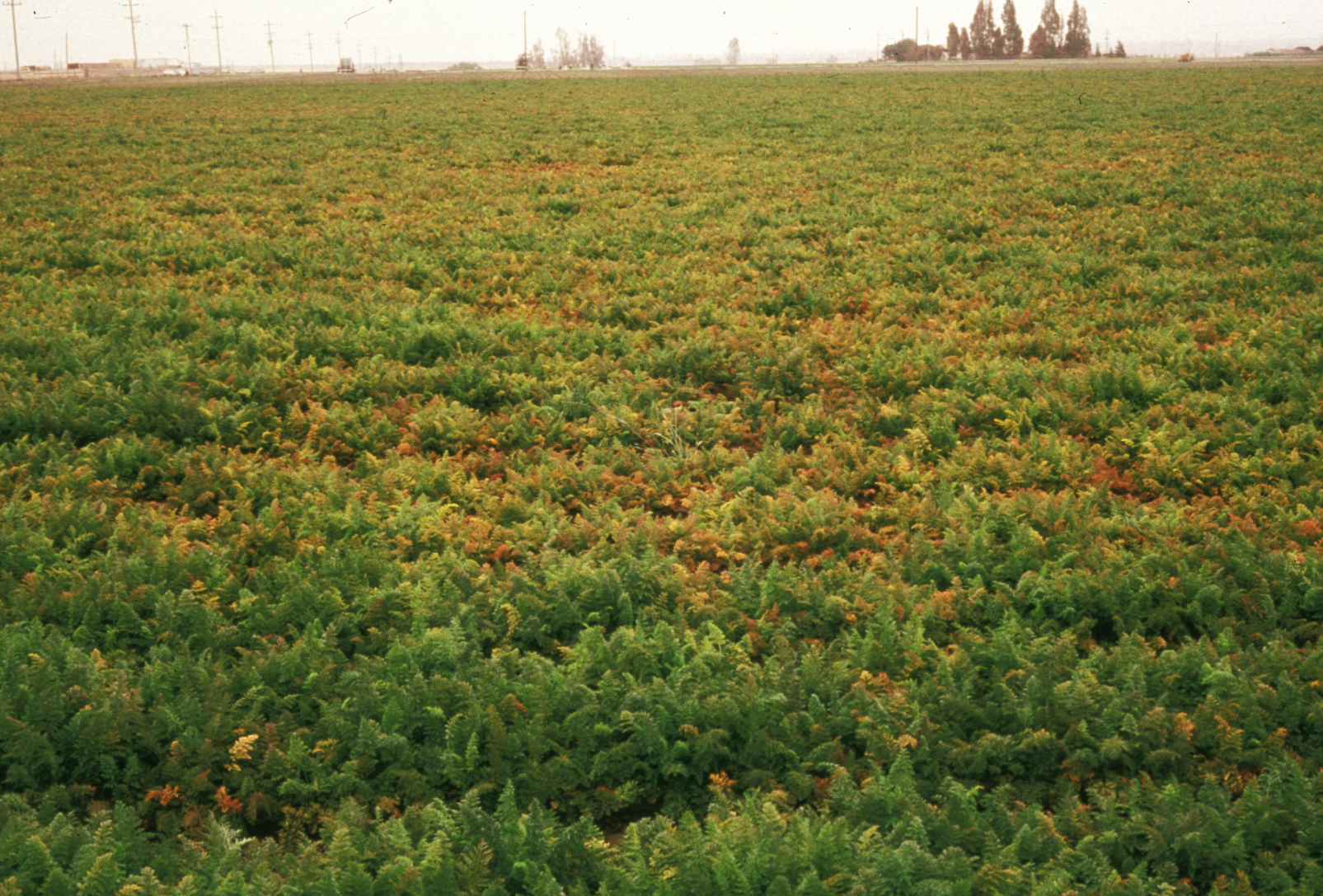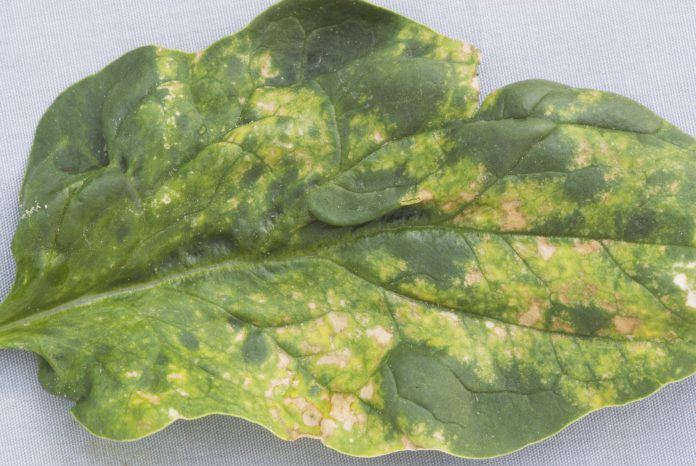
Farmers and other field professionals producing vegetable crops face a bewildering array of challenges. Insects and mites feed on, disfigure, and eat away at produce quality. Weeds compete with the vegetables for precious resources and can require extensive labor to be removed. Fertilizer and water inputs can be costly. The economic cycle of planting, growing, harvesting, and marketing can be a “black hole” that engulfs company resources while offering few guarantees of profits. Another group of challenges is embodied by the many plant pathogens that cause diseases of vegetable crops. One particular group of pathogens of interest are the viruses that infect plants.
Virus Pathogens of Plants
Viruses that infect plants are similar, in shape and constitution, to the viruses that infect insects, animals, and yes, people. A virus consists of a piece or two of genetic material (either DNA or RNA) that is surrounded and protected by a protein coat or covering. In the grand scheme of biology, such a nucleic acid + protein structure is extremely simple and basic. This entity is also extremely tiny. Since a virus is composed of two types of chemicals, it is much smaller than a plant cell and cannot be observed with a regular microscope. Only with the use of electron microscopes can the body of the virus be observed. The outer protein coat gives the virus a distinctive shape, and plant viruses can look like long flexible threads, short rigid rods, or spherical, geometric polyhedrals.
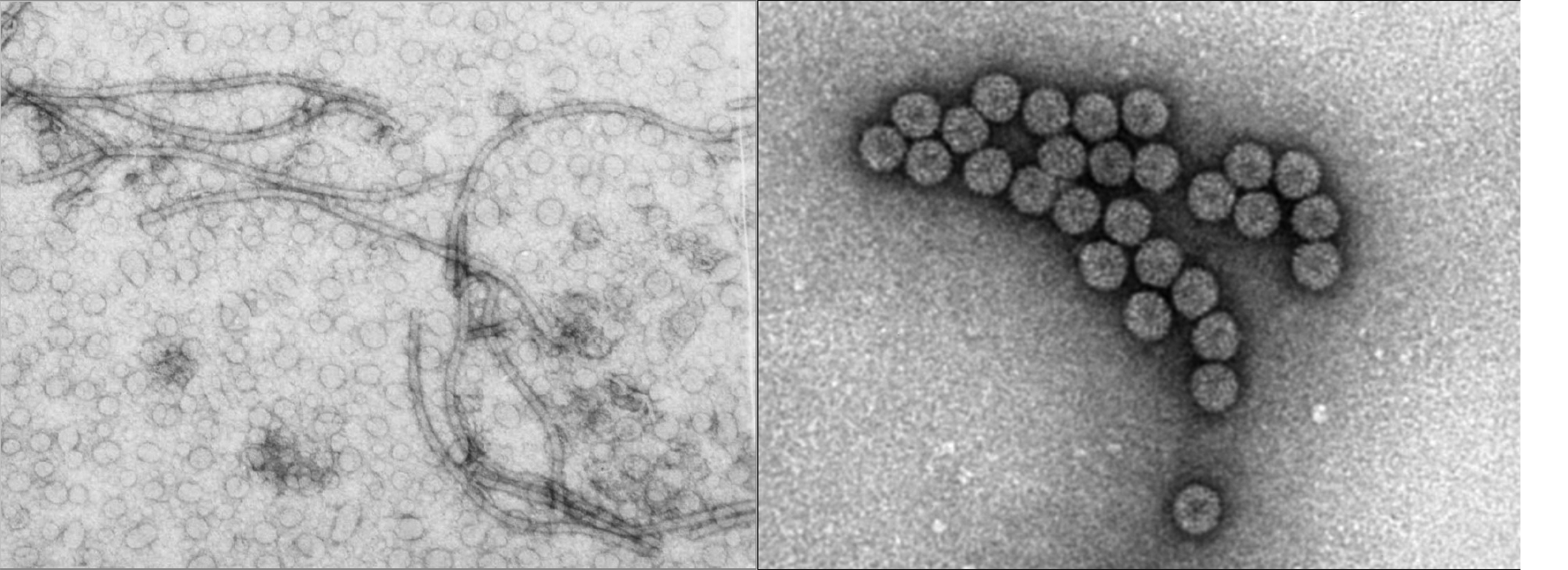
Plant viruses, like all viruses, do not function or operate outside of their hosts. To become active the virus must be introduced into a living plant cell, after which the virus mechanism activates and highjacks the cell’s processes, forcing the host cell to produce more virus RNA or DNA and virus proteins. These components are assembled into new viruses which are then translocated throughout the plant by being carried in plant fluids that stream into stems, leaves, flowers, and fruits.
Diseases Caused by Viruses
As with viruses that infect people and animals, plant pathogenic viruses at first show no evidence of their initial incursion into the host. There is a latent period or lag-time during which the virus is steadily orchestrating the manufacture of additional virus nucleic acids and proteins. At a certain critical point, the virus population causes enough physiological and metabolic disruption so as to cause visible symptoms, which collectively we call the disease.
Disease symptoms caused by viruses can vary greatly and are influenced by the vegetable variety, age of plant when first infected, the strain of the virus, and environmental conditions under which the crop is grown. In general, vegetable crops infected with viruses will show one or more types of foliar symptoms. Leaf color changes with the development of yellow or brown spots, light and dark green patterns (mosaic, mottling), concentric ring patterns (ringspot), and yellow or white blotches and streaks. In some cases, the entire foliage of the plant turns yellow, orange, or red. Some viruses cause a curious reaction where only the veins of the leaf become yellow or brown. Leaves can be misshapen in various ways, from simple curling, to unusual elongation (strap leaf), to severe twisting and deformation. Internodes along the stem become abnormally shortened, resulting in tight bunching of leaves. Flowers also change appearance with streaks of color in the petals (color break). For fruiting vegetables, the fruit may show only subtle color breaks and patterns, or alternatively become grossly deformed. Overall plant growth can be stunted and crop development can be delayed.
All vegetable crops suffer from at least one virus pathogen, while some crops are subject to a dozen different ones. Table 1 lists selected vegetable crops and some of the viruses affecting these crops in the U.S. Like fungal and bacterial pathogens, virus pathogen occurrence and importance vary with geographic region. A virus that is important on California lettuce may be incidental or lacking on lettuce in Florida. Likewise, the set of viruses that North American tomato growers must deal with will be different than tomato viruses occurring in South America or Asia.
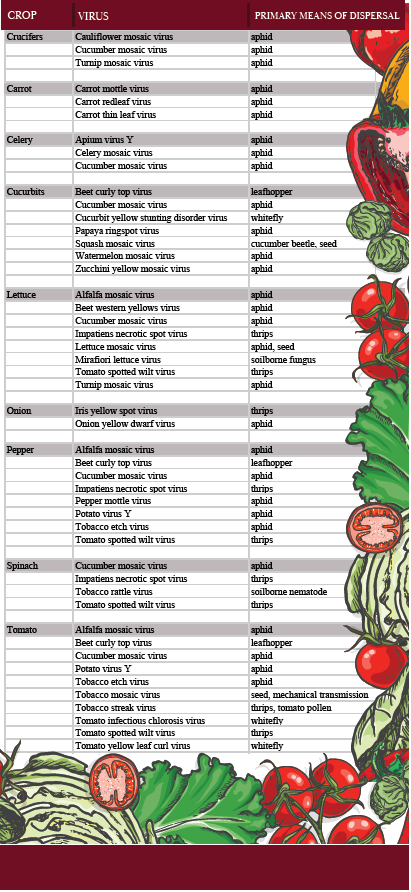
The economic impact of a particular crop-virus interaction depends on the inherent aggressiveness of the virus, incidence of the disease, and the susceptibility of the crop. Regarding the crop, a critically important factor is the type of harvested commodity. For example, leafy commodities such as lettuce and spinach will be especially vulnerable to viruses that cause leaf symptoms. The viruses of pepper that cause fruit malformations are more important than the pepper viruses that only cause mild mosaics in the foliage. For celery grown in California, cucumber mosaic virus (CMV) causes some leaf mosaic and mottling but rarely causes any symptoms on the celery petioles and, therefore, is of little concern. However, a different virus, Apium Virus Y, can cause celery petioles to turn brown, making the celery unmarketable.
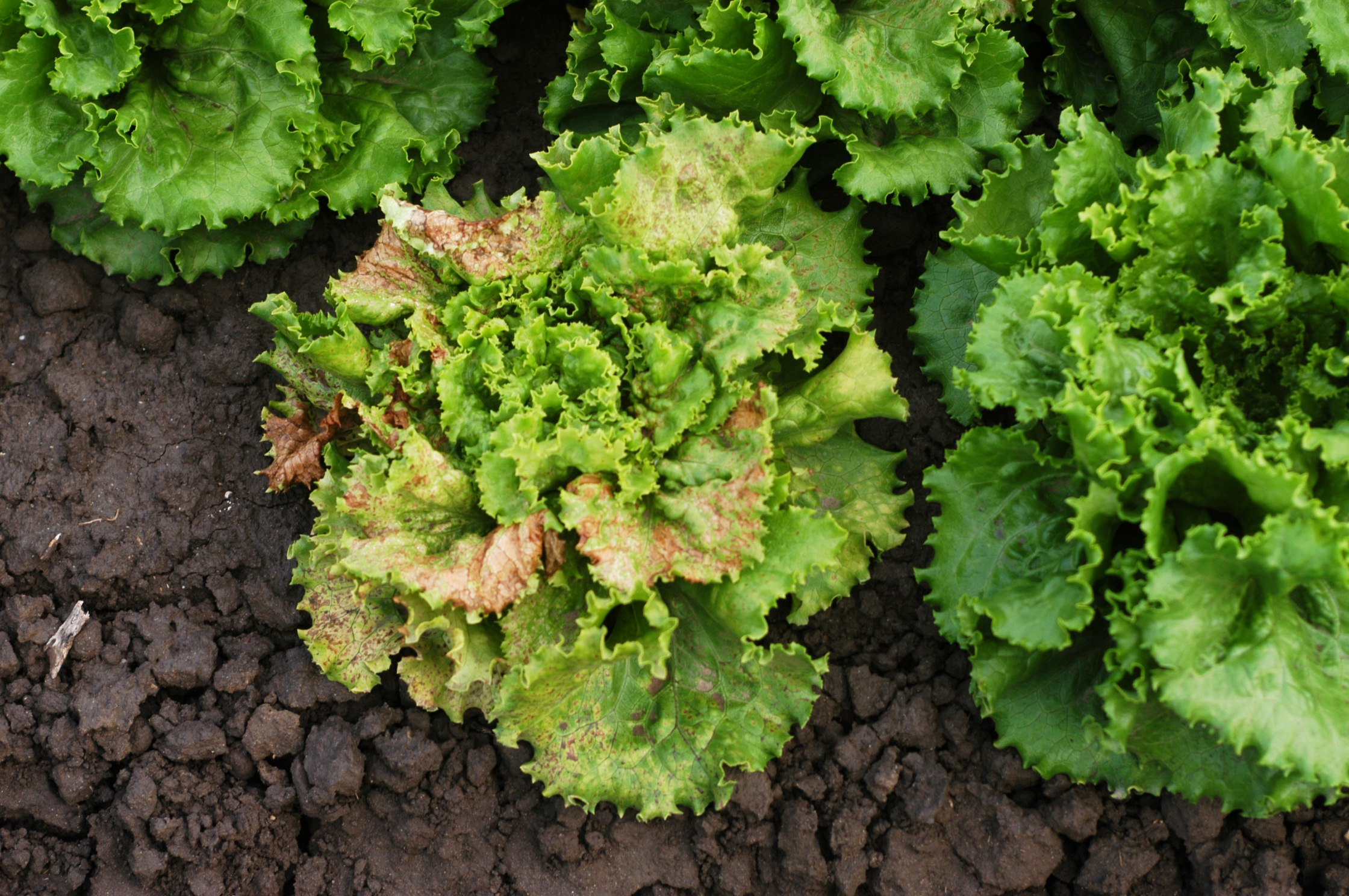
Detecting and Diagnosing Viruses
Confirmation of a virus requires testing. We acknowledge that experienced growers and field personnel, who have looked at virus diseases of a particular crop for many years, can develop a good diagnostic sense for such problems. However, to be scientifically sound and accurate, diagnosing virus diseases cannot be achieved without clinical testing. Virus disease symptoms pose particular challenges to diagnosticians because the wide range of virus-like symptoms can also be caused by other factors.
Symptoms caused by viruses can also be caused by genetic disorders, nutritional imbalances, environmental extremes, phytotoxicity from pesticides and fertilizers, and other factors (see Table 2.) Fortunately, diagnostic labs have the tools that can identify most of the commonly occurring viruses in vegetables. Such tests rely on either serology (using antibodies that detect the antigens of virus proteins) or molecular biology (using probes that recognize nucleic acid sequences of the virus.)

Epidemiology of Virus Diseases
Development of virus diseases of plants involves several factors. In contrast to some human viruses, plant viruses are not moved around in the air or deposited on surfaces waiting to come into contact with a plant. Rather, plant pathogenic viruses typically originate from a living source or “reservoir.” (Factor 1) The reservoir is often an infected weed that is near the site where the vegetable crop will be planted, or the reservoir can be an infected volunteer crop plant in the field. Vectors (Factor 2) are the insects, mites, and nematodes that have fed on a virus-infected plant, ingested virus particles, and now are capable of injecting the viruses into the next plant that is fed upon. For the great majority of viruses that infect vegetables, the viruses are moved by vectors from reservoir hosts to healthy crops (Factor 3). Aphids are the most common vectors (See Table 1.) Other insects (thrips, leafhoppers, beetles) also carry viruses, as do a few soilborne nematodes and one soilborne fungus.

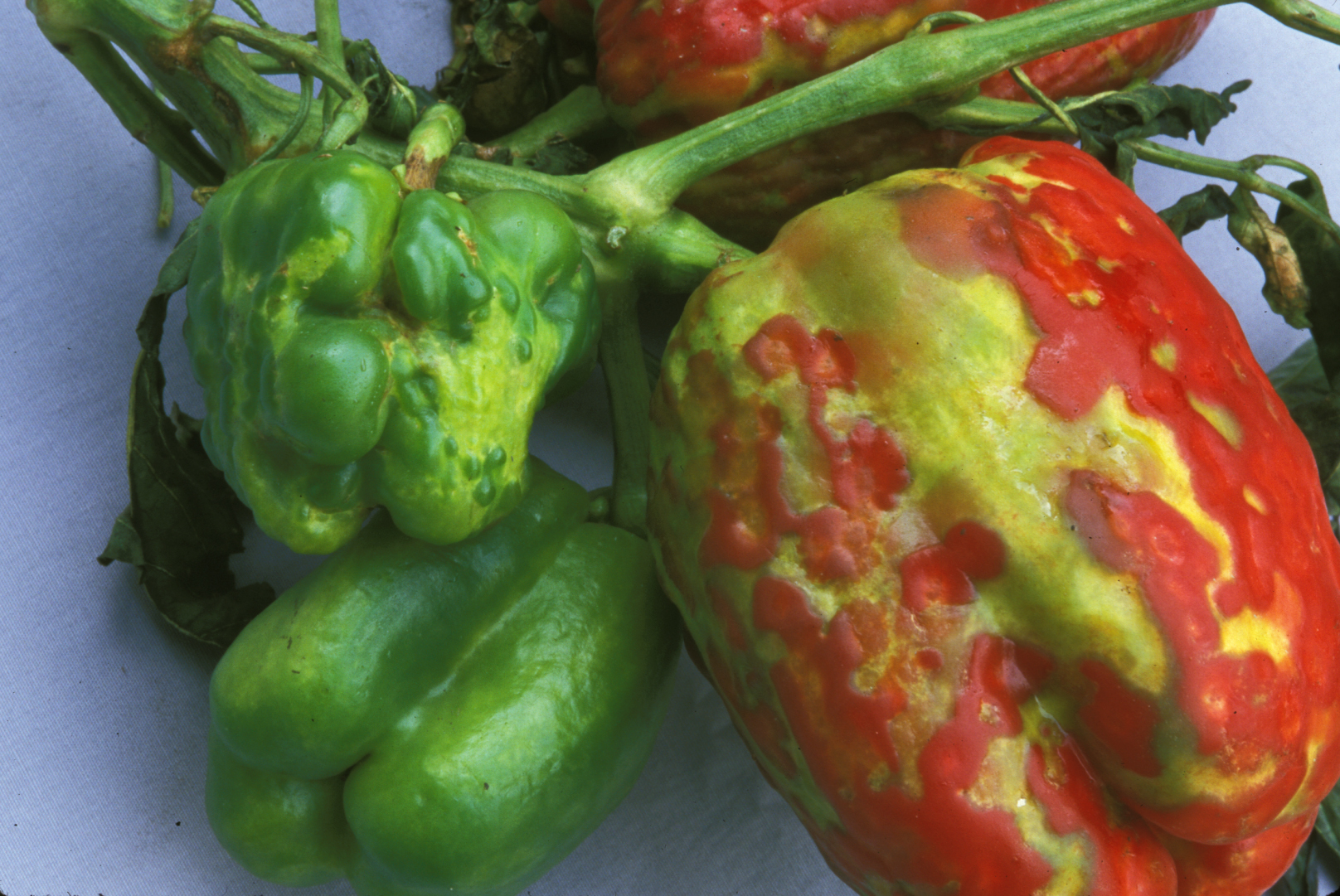
The epidemiology, or progress of disease spread, depends on the complex interaction of the three factors mentioned above.
Factor 1 Reservoir: What is the nature of the virus reservoir? Which weed species are present? Are there high numbers of virus-infected weeds or volunteer plants in the area? A virus with a broad host range, such as Tomato spotted wilt virus (TSWV), may be present in dozens of weeds and numerous volunteer plants on a particular ranch.
Factor 2 Vector: Which vectors are in the vicinity? What are their populations and dispersal patterns? How do wind patterns and geographic features influence dispersal? What is the extent of vector increase within the crop, which can result in plant-to-plant spread within that planting?
Factor 3 Vegetable Crop: What is the crop diversity in the area being considered and which viruses affect these crops? For example, could CMV, which has a broad host range, spread between different vegetables? If the region is widely planted to one crop, such as lettuce, will a particular virus affect many lettuce plantings? Too much of the same crop, densely cropped in one region, could result in rapid virus spread and disease epidemics. In contrast, if a region has only one onion field among many non-allium crops, a narrow host-range pathogen such as Iris yellow spot virus will infect only the onions. The answers to these and other questions have significant bearing on the management of virus diseases.
Managing Virus Diseases
Diagnosis: The first step in disease management is accurately identifying the precise pathogen involved. Molecular and serological assays are available for most of the major virus pathogens affecting vegetables. Knowing which virus is involved enables one to know the reservoir plants harboring the virus, the vectors involved, and the potential target crops.
Exclusion: Prevent the virus from entering the production system. For lettuce, cucurbits and tomato, some viruses are carried in the seed; therefore, use seed that has been tested or certified to not harbor the pathogen. For crops started as transplants, employ IPM practices to prevent infection at the transplant stage. Note that for the few vegetable crops propagated by cuttings or plant divisions (example: artichoke), viruses will be readily spread if infected propagative material is used to plant new fields.
Reservoir host eradication: Remove the initial sources of the virus, which are infected weeds and volunteer crop plants. Plant viruses are present mostly in living plants and generally not in soil, water, equipment surfaces, or the air. Controlling weeds and other reservoir plants is therefore a critical part of virus control.
Manage the vectors: Use IPM practices to control the virus vectors. The great majority of vegetable-infecting viruses only reach a crop via an insect vector. Complete control of an insect pest is rarely possible, so strategies should attempt to manage the insects as best as possible. Keep in mind that the vectors are also present on the reservoir weeds and plants outside of the field. Once a virus is introduced into the crop, intra-field, plant-to-plant spread will be achieved only through movement of the vector.
Destruction of the old crop: Once a crop has been harvested, the passed-over plants and shoots growing from remaining crop roots can serve as virus reservoirs if they are infected. Old vegetable fields should, therefore, be disked and plowed under in a timely manner.
Resistant cultivars: If available, growers should select cultivars that are bred to be resistant to the virus pathogens. Note, however, that the usefulness of such genetic plant resistance may not last. Researchers found that the use of tomato and pepper cultivars resistant to TSWV has allowed for the development of “resistance breaking” (RB) strains of the virus. Through mutation and selection, these new strains of TSWV can cause disease in the previously resistant cultivars.
Chemicals or pesticides: Currently there are no chemical treatments that can be applied to plants that would prevent infection from viruses or prevent development of virus disease.
